- Biotic vs. Abiotic Diseases
- Step-by-Step Diagnosis of Turfgrass Injuries or Disorders
- Common Abiotic Turfgrass Disorders
- Summary of Abiotic Diseases
- References
Biotic vs. Abiotic Problems
Turfgrass stands can be injured and damaged by biotic (living) and abiotic (non-living) agents. Biotic agents include pathogens (fungi, bacteria, viruses, phytoplasma, mollicutes) and pests such as nematodes, insects, mites, mollusks and vertebrates (e.g., rodents, birds etc.). Abiotic agents or factors include environmental conditions such as extreme temperatures; excess or deficient water, light or nutrients; soil compaction; and abnormal conditions such as drought, flooding and/or adverse cultural practices.
Abiotic problems can result from an interaction that has been in effect for an extended period of time, between the plant and one or more factors such as lack of space for root growth or the presence of chronic or acute levels of air or water pollutants. Examples of cultural practices that may cause damage are soil compaction from mowing or traffic, drifting of herbicides applied to control weeds, and mechanical injury from dull mowers. Most abiotic diseases cause generalized symptoms such as wilting, yellowing, thinning and the development of smaller than normal grass blades, limited root growth or slow growth.
Based solely on symptoms, however, determining whether the condition is caused by a biotic or an abiotic agent can be challenging. In many cases, a proper diagnosis of abiotic diseases requires thorough examination of the site, knowledge of relevant past and present environmental conditions, in-depth knowledge of plant species biology, site management history, and an orderly series of tests to determine possible causes.
Some general characteristics that can help to differentiate between biotic and abiotic stresses include:
Biotic
- Physical evidence (signs) of the causal organism may be present when stress is caused by a biological organism (insects may be present, fungal mycelium or spore masses may be visible, animal burrows evident).
- Biotic diseases might spread progressively (brown, yellowing patches grow and coalesce over time).
- Biotic diseases affecting turfgrass stands can not be found on other plant species in the area.
Abiotic
- Physical evidence may not be present on turfgrass plants. Nutrient deficiencies, chemical toxicities, aeration deficits or cold injury produce symptoms but do not leave any signs (physical evidence).
- Abiotic damage may or may not develop progressively through the turfgrass area. In a number of cases, abiotic damage appears suddenly.
- Abiotic damage may affect numerous plant species around the site where turfgrass is grown.
Step-by-Step Approach to Diagnosis of Turfgrass Injuries and Disorders
- Identify the host.
Identifying the turfgrass species is the essential first step in diagnosing the problem. Determine genus, species and cultivar if possible. Anticipate management strategies of that particular species.
- Identify the symptoms.
Examine injured parts and list the symptoms. Is injured part chlorotic, necrotic, discolored or distorted? Are the symptoms in patches, yellowing, leaf spots?
- Inspect the whole plant.
Collect a representative sample with a range of symptoms, including grass blades and roots.
- Inspect the site and ask questions.
Examine the turfgrass sward environment and look at conditions that may have contributed to the injury.- Is the terrain sloped, does the soil appear well drained?
- Is the site windy, hot, cold, shaded, exposed, etc.?
- Was anything sprayed?
- When did you notice the problem?
- What cultural practices have been performed recently? etc.
- Look for patterns.
- Are symptoms uniform throughout the area?
- Is turfgrass the only plant species affected?
- Do the symptoms form a pattern in the landscape?
- Are the symptoms related to topography?
- Are symptoms related to wind pattern?
- Evaluate soil physical characteristics and chemical properties.
- Soil pH, relative nutrient availability, base saturation.
- Recent soil tests, recent fertilization practices.
- Soil compaction status.
- Buried debris present?
- Investigate the plant management history.
- Contact the person who has knowledge of the site.
- Collect as much background information as possible.
- When was the site planted?
- Have there been previous problems?
- What is the regime for irrigation, fertilization, soil amendments, pest management, etc.?
- Synthesize information.
When you have finished collecting information about the turfgrass and site, identify potential causes.
- Test likely causes and consult resources.
Submit samples to agricultural or plant disease laboratories for support; use literature and resources to reach a diagnosis.
Common Abiotic Turfgrass Disorders
Environmental Extremes
Moisture Extremes
Turfgrass plants require sufficient moisture to grow but not so much that the roots “drown.” Related is soil compaction, where equipment or foot traffic reduces the pore space in the soil. Reduced pore space decreases the voids in the soil where soil moisture and air are retained. Also, percolation of water through the soil profile is disrupted, so that the desirable air/ moisture balance is not maintained. Roots can die from a lack of oxygen. Drought damage develops in plants when water use rate or evapotranspiration rate exceeds the rate of water absorption by the roots. As the soil dries, the ability of roots to absorb water decreases and moisture stress develops. As this condition intensifies, leaves lose turgor, wilt, turn yellow, and eventually die. Water deficiency is normally corrected by rainfall or supplemental irrigation.
Saturated Soil/Flooding or Standing Water
Soil saturation or flooding caused by excessive rainfall or irrigation creates an unfavorable soil environment for root growth by displacing oxygen present in the soil pores with water. Without oxygen, root growth is restricted and, in extreme cases, toxic gases such as hydrogen sulfides (H2S) and metallic sulfides, can accumulate. The result is plants being weakened and killed. Soils with moisture in pores resists temperature changes better than dry soils; therefore water logged soils stay warmer for longer periods and can increase turfgrass damage.
Turfgrass injury due to flooding appears as dead brown areas. Symptoms appear a few days after the flood water recedes, and the injured areas will follow the outline of low flooded areas. Under long periods of submersion, the turfgrass can become partially rotten. As with diagnosis of many turfgrass problems, history of the area is critical to correct identification of the problem. To alleviate the problem, increase surface and internal soil drainage. Major additional problems associated with excess water are diseases that thrive under extremely moist conditions and take advantage of the stressed plants.
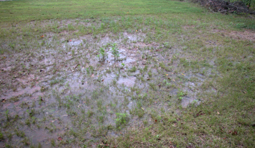 Turfgrass damage due to excessive wet or low areas. [Photo: Alfredo Martinez]
Turfgrass damage due to excessive wet or low areas. [Photo: Alfredo Martinez]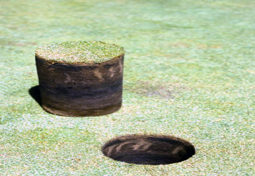 Black layer due to high soil moisture and compaction. [Photo: Lee Burpee]
Black layer due to high soil moisture and compaction. [Photo: Lee Burpee]
Drought Injury
Drought can broadly be defined as a low water availability that limits or prevents turfgrass growth. The severity of drought depends on the duration. Turfgrass species differ greatly in their ability to withstand drought conditions. Symptoms of drought stress begin with the turfgrass presenting a bluish color, followed by leaf rolling and eventual browning. Drought stressed turfgrass is often found near sidewalks, driveways or buildings, and at the tops of slopes. Drought stress also can be observed as localized dry spots that appear as irregular patterns of dead and dying turfgrass.
Causes of localized dry spots include sandy soils, compaction, buried building materials, algal infestations, fairy rings, and excessive thatch problems. Curative measures include selection of more drought resistant grasses, proper irrigation practices, core aerification, the use of wetting agents, and removal of buried materials. During drought conditions, many turfgrass species go into a state of dormancy and their tissues become brittle and are susceptible to bruising. Symptoms of bruising are the entire shoot appearing brown or brown streaks on the blades. This is more easily observed after dormancy is broken and growth resumes as injured leaves and shoots fail to grow. The pattern of injury often is associated with other mechanical stresses such as footprints or wheel tracks.
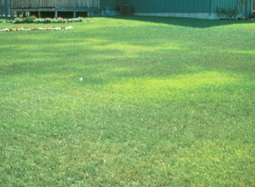 Drought injury. [Photos: Colorado State University and the University of Florida]
Drought injury. [Photos: Colorado State University and the University of Florida]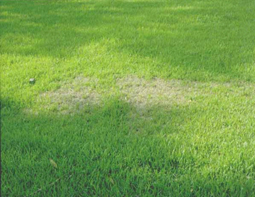 Drought injury. [Photos: Colorado State University and the University of Florida]
Drought injury. [Photos: Colorado State University and the University of Florida]
Temperature Extremes
High Temperature Injury
Turfgrasses vary in their tolerance to high temperatures. Cool season grasses are much more susceptible to high temperatures than warm season grasses. Often high temperature is combined with drought injury. The effect of high temperatures on turfgrass is the creation of metabolic imbalances. Under normal ambient temperatures, plant enzyme systems become more active as temperatures increase; however, once temperatures exceed the optimum for growth, enzyme systems shut down.
In addition to reduced growth, temperatures above 105 degrees F can break down these enzymes, causing further plant injury. While ambient temperatures rarely exceed this threshold in Georgia, turfgrass canopy temperatures can exceed this temperature, especially under drought stress. Drought stressed turfgrass canopies can have temperatures 15 degrees F to 25 degrees F higher than ambient conditions. In hot summer months, canopy temperatures have been shown to be cooler when turf is maintained at higher mowing heights.
High temperature damage can be caused by direct solar radiation, reflected solar radiation from windows or other similar reflective surfaces, objects (containers of hot liquids, metal pails, storm window, etc.) placed on turfgrass in full sunlight, and lightning strikes. These heat sources are most detrimental when grasses are not able to cool themselves by evapotranspiration. When turfgrass is covered by any non-permeable material, humidity levels increase and evaporative cooling does not occur, which causes scalding. Initially turfgrass will appear water soaked, but eventually it turns brown. To avoid damage, select more heat tolerant grasses and consider syringing or applying water to the turfgrass during hot spells to help keep its canopy cooler.
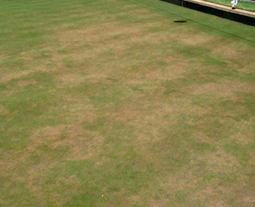 Heat damage. [Photos: Purdue University]
Heat damage. [Photos: Purdue University]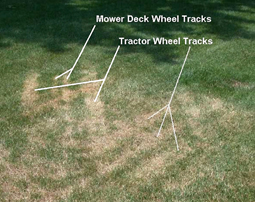 Heat damage. [Photos: Purdue University]
Heat damage. [Photos: Purdue University]
Low Temperature Injury
Extremely low temperatures can also damage turfgrass. Low temperature injury results from freezing of crown tissue, the part of the plant responsible for shoot and root growth. Repeated or constant freezing of the crowns can cause dehydration and eventual death of the plant.
Damage is typically associated with inadequate water availability in plant tissue. Symptoms of cold injury are straw brown colored turfgrass but are generally detected once environmental conditions have become favorable for growth and the grass fails to green-up. Another form of low temperature injury is winter desiccation, which can result from drought brought on by windy conditions, low humidity and high solar radiation during periods of cold weather. These conditions are favorable for desiccation, drying out, of the plant tissue. Once the plant, even in the state of dormancy, becomes desiccated, it stops growing and dies. These factors are accentuated in elevated areas of the landscape.
Protective measures include top dressing with sand and using winter covers (blankets) on golf greens. In addition, periodic light watering when air temperatures are above freezing can reduce injury. Selecting grasses tolerant of low temperatures is beneficial. Most turfgrass species grown in Georgia can survive normal cold spells. However, turfgrass loss is not un-common during extreme and prolonged cold conditions or when climatic conditions are favorable for desiccation. Warm season grasses may be severely injured or killed when the plants emerge from winter dormancy. Intermittent warm weather can induce plants to resume growth and thereby use stored energy reserves (carbohydrates). If freezing temperatures occur, however, the turfgrasses are less capable of emerging from winter dormancy and may be killed altogether.
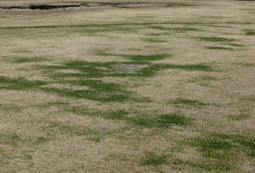 Zoysiagrass affected by cold temperatures. [Photo: Alfredo Martinez]
Zoysiagrass affected by cold temperatures. [Photo: Alfredo Martinez]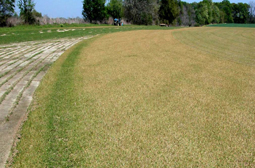 Bentgrass affected by cold temperatures. [Photo: Clint Waltz]
Bentgrass affected by cold temperatures. [Photo: Clint Waltz]
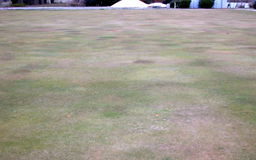 Centipedegrass affected by cold temperatures. [Photo: Alfredo Martinez]
Centipedegrass affected by cold temperatures. [Photo: Alfredo Martinez]
Chemical Injuries
Pesticide/Herbicide Damage
When chemicals are applied for turf management, there is risk of applicator errors causing turfgrass damage. Many pesticides used for weed control and turfgrass disease control, and other pest management chemicals, have growth regulating properties. Misapplication of pesticides may cause injury or irregular growth.
Pesticide injury is easily differentiated from disease and insect injury. Generally the damage will appear in a pattern that corresponds to the method of application and includes broad to narrow streaks, corresponding to overlapped application or other regular patterns. Specific signs of this type of injury include lack of pest control, turfgrass chlorosis, leaf speckling and death. These symptoms can develop quickly after application or several weeks later.
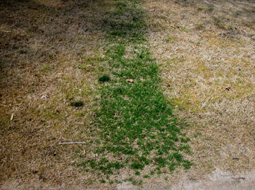 Herbicide damage on Bermudagrass. [Photo: Alfredo Martinez]
Herbicide damage on Bermudagrass. [Photo: Alfredo Martinez]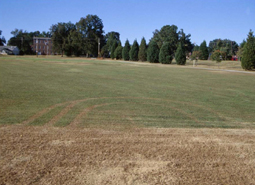 Herbicide tracking. [Photo: Clint Waltz]
Herbicide tracking. [Photo: Clint Waltz]
Options for correcting the problem include proper calibration, avoiding overlaps, making applications at labeled rates, rotating the site into a fallow area, and, in the case of certain herbicide misapplication, using activated charcoal to absorb or deactivate the chemical. Apply any pesticide to turfgrass to improve plant health (e.g., fungicides, herbicides and insecticides) in accordance with the product label.
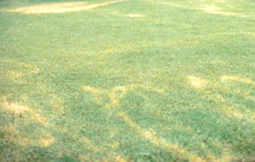 Herbicide damage. [Photo: University of Kansas]
Herbicide damage. [Photo: University of Kansas]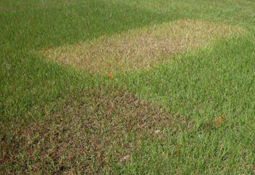 Damage from herbicides on an experimental field. [Photo: Alfredo Martinez]
Damage from herbicides on an experimental field. [Photo: Alfredo Martinez]
Fertilizer Damage
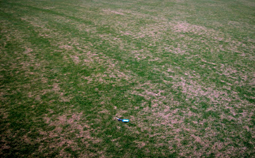 Fertilizer misapplication. [Photo: Alfredo Martinez]
Fertilizer misapplication. [Photo: Alfredo Martinez]Excess fertilizer rates disrupt the nutrient balances in grass plants or soil systems. When too much fertilizer is applied, excessive
growth is favored, which may result in scalping damage during mowing and disrupts the nutrient balance in the soil (e.g., too much phosphorous can bind iron, rendering it unavailable for plant uptake). When highly water-soluble nitrogen fertilizers, such as urea, are applied to wet turfgrass or during high temperatures, “burn” or desiccation of leaf tissues can result.
One option to reduce fertilizer damage is to thoroughly water in the fertilizer after application to remove any spills or residues from the leaf surfaces. Low application rates associated with misapplication also can cause problems. Turfgrass often will appear to have green shaded stripes caused by not properly overlapping the fertilizer spreader paths. Always apply fertilizers evenly and at the proper time and rate. Calibrate granular applicators regularly to deliver the proper amount of fertilizer.
 Fertilizer skips. [Photo: Clint Waltz]
Fertilizer skips. [Photo: Clint Waltz]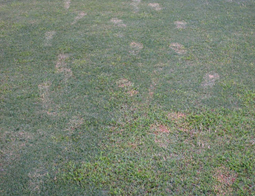 Ammonium nitrate injury. [Photo: Clint Waltz]
Ammonium nitrate injury. [Photo: Clint Waltz]
Fuel and Oil Spills
Fuel and oil spills can severely damage turfgrass. Most of these chemicals do not include growth beneficial compounds, so turfgrass will often die in the concentrated area of the spill. The spot will have abrupt margins and possibly be irregular in shape. Hydraulic fluid spills often produce straight line patterns. Injury from gasoline often appears as a roughly circular dead area with a definite margin. To reduce damage, fresh spills can be treated with detergent followed by an absorbent, such as activated charcoal to reduce damage. Acting quickly and containing the spill with absorbent materials will greatly reduce damage. In extreme circumstances, small damaged areas can be cut out and replaced.
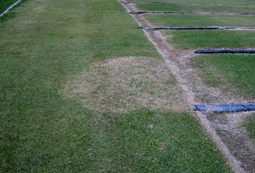 Lubricant spill. [Photo: Alfredo Martinez]
Lubricant spill. [Photo: Alfredo Martinez]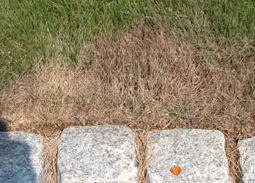 Exhaust damage. [Photo: Clint Waltz]
Exhaust damage. [Photo: Clint Waltz]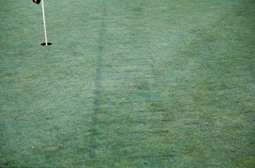 Battery acid tracking. [Photo: Clint Waltz]
Battery acid tracking. [Photo: Clint Waltz]
Nutrient Deficiencies
Symptoms from nutrient deficiencies are seen only under extreme cases of fertility misapplications (i.e., not overlapping properly).
Nitrogen Deficiency
General yellowing or chlorosis seen initially in the older leaves is a symptom of nitrogen (N) deficiency. Common symptoms include tip dieback and decreased shoot density and tillering. This is the most common nutrient deficiency observed in turfgrasses. Nitrogen deficiency occurs because of the relatively high nitrogen requirement by most turfgrass species and the inability of most soils to meet this requirement without fertilizer applications. Turfgrass diseases also are greatly affected by nitrogen fertility. Brown patch in cool season grasses may be more active under high levels of nitrogen fertility. In contrast, dollar spot and rust are more active under low levels of nitrogen fertility. By maintaining an adequate nitrogen level, disease management can be enhanced.
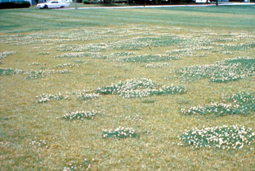 Nitrogen deficiency. [Photo: Kansas State University]
Nitrogen deficiency. [Photo: Kansas State University]Phosphorus Deficiency
A dark green color that progresses to a purplish to reddish purple color, mostly in the older leaves, is a common leaf symptom of phosphorus (P) deficiency. A phosphorus deficient turfgrass may appear wilted and be confused with one suffering from drought stress. While leaf symptoms associated with phosphorus deficiency may not be evident, turfgrass performance can be affected greatly. Seedling establishment has been shown to be improved by phosphorus fertility. A high phosphorus fertilizer is recommended for newly seeded areas. Centipedegrass is an exception, and phosphorous application should be made according to soil tests. Because of potential water contamination, apply phosphorous only according to soil test recommendations.
Potassium Deficiency
Yellowing of older leaves followed by tip die-back and necrosis along the leaf margin are signs of potassium (K) deficiency. Typically, symptoms are more likely to appear as increased susceptibility to other stresses. Overall turfgrass may appear chlorotic and have lower spring quality and reduced tolerance to heat. However, potassium deficiency is rarely reported and it has been suggested that mild deficiencies are rather common. Among various turfgrass species, adequate potassium has been shown to increase establishment, spring performance and stress tolerance to cold, heat, and wear.
Iron Deficiency
Interveinal chlorosis occurring initially in the young leaves is a sign of iron (Fe) deficiency; in extreme cases leaves can appear almost white. Iron deficiencies result in the loss of an upright growth habit. Turfgrass stands appear matted and are often difficult to mow. Iron deficient turfgrass may appear as a mosaic of chlorotic patches. Soil conditions leading to iron deficiencies include high pH, high soil phosphorus levels, high soil nitrogen levels, sandy soils and cold, wet soils. Many products are available for foliar application of chelated iron. Color enhancement occurs within hours of the application and lasts two to three weeks during wet periods or several months during cool, dry periods, depending on growth conditions.
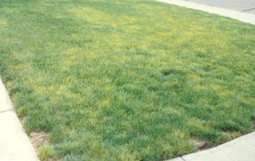 Iron deficiency. [Photo: Kansas State University]
Iron deficiency. [Photo: Kansas State University]
Mechanical Injury
Scalping
Removing too much of the turfgrass canopy at one cutting can often cause stress and plant death. This is typically a problem in uneven landscapes.
Symptoms of scalping can be seen as brown and yellow turfgrass with stem-like canopies. The stem appearance results from removing excess vegetation. Damaged areas in rhizomatous or stoloniferous species are normally self-healing (i.e., bermudagrass, zoysiagrass, etc.). Non-stoloniferous grasses, such as tall fescue, may require reseeding.
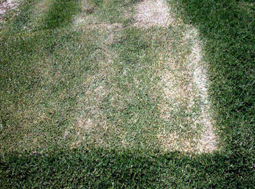 Scalping injury on bermudagrass. [Photo: Alfredo Martinez]
Scalping injury on bermudagrass. [Photo: Alfredo Martinez]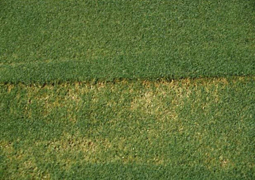 Scalping injury on bentgrass. [Photo: Clint Waltz]
Scalping injury on bentgrass. [Photo: Clint Waltz]
Dull Blade Injury
Dull mower blades shred the tips of grass blades. Affected blades appear to have small “threads” extending from them. These threads are the protruding vascular bundles of the grass blades. Shredding of the tips causes them to turn “straw-brown” and gives the overall turfgrass canopy a grayish or whitish cast.
In addition to decreasing the aesthetic appearance of the turfgrass, mower blade injury opens the grass plant up to infection, since the mycelium from certain fungal pathogens can enter the leaf through these frayed ends. The best way to relieve these symptoms is to have sharp blades and well maintained mowers.
 Dull mower blade injury. [Photo: Alfredo Martinez]
Dull mower blade injury. [Photo: Alfredo Martinez]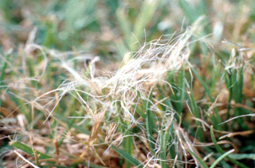 Dull mower blade/shredding injury. [Photo: Kansas State University]
Dull mower blade/shredding injury. [Photo: Kansas State University]
Soil Compaction
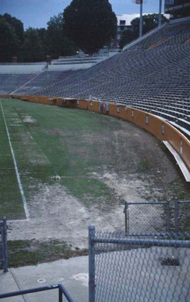 Soil compaction. [Photo: Clint Waltz]
Soil compaction. [Photo: Clint Waltz]Turfgrass in high traffic areas may suffer from problems not always obvious to the eye. Shallow soils and compaction can result
in root growth being restricted. The result is increased sensitivity to environmental fluctuations. Soils under turfgrasses in high traffic areas are often compacted, which restricts water infiltration and percolation, gas exchange, nutrient acquisition and ultimately root growth. Compacted areas often conform to foot-paths and areas where heavy equipment continuously follows the same routes.
Symptoms of compaction include thinned turfgrass; increased sensitivity to drought; rust diseases, weed infestations and temperature stresses. Turfgrasses in these areas appears brown or to have low overall turfgrass quality. Extensive renovations or mechanical aeration can help correct compaction depending on the extent of the problem. In the long run, redirection of traffic from the problematic area will prove beneficial. Turfgrasses that show increased tolerance to both wear and compaction also can be selected. The goal of any corrective measure is to improve the soil environment and stimulate deep rooting, which allow the grass to recover from use and moderate environmental stresses.
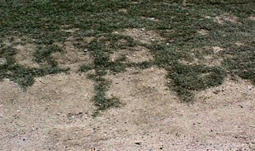 Soil compaction. [Photo: Utah State University]
Soil compaction. [Photo: Utah State University]
Summary of Abiotic Diseases of Turfgrass
|
Injury or Disorder |
Symptoms |
Management |
|
Moisture Extremes |
||
|
High humidity, Flood, Standing water |
Brown turfgrass that follows the outline of flooded areas; scalding; turfgrass partially rotten. |
Increase surface and soil drainage; soil grading; reduce irrigation regime; avoid traffic. |
|
Drought |
Bluish color; leaf rolling, browning of turfgrass; tissue becomes brittle. |
Irrigate affected area; use wetting agents; aerify to improve water penetration; reduce traffic. |
|
Temperature Extremes |
||
|
High temperature |
Scalding; turfgrass with water-soaked appearance; brown turfgrass. |
Select heat tolerant grasses. Syringe turfgrass canopy with water. |
|
Low temperature, Frost injury |
Straw-brown turfgrass; bleached or dead grass, especially in windy areas. |
Top dressing; winter blankets; light watering when temperatures are above freezing. |
|
Chemical Injuries |
||
|
Herbicide, pesticide damage |
Irregular growth; damage appears in patches, streaks or bands; chlorosis; leaf speckling. |
Remove soil; bioremediation; use activated charcoal to absorb chemical; apply pesticides according to label. |
|
Fertilizer |
Turfgrass suddenly appears scorched; bands, streaks or irregular patterns; grass stimulated at margins. |
Apply fertilizer at proper time and rate; apply fertilizer evenly; calibrate equipment regularly. |
|
Lubricants, Oil, Gasoline spills |
Dead areas with abrupt margins. |
Fresh spills treated with detergent then with activated charcoal; replace affected areas. |
|
Nutrient Deficiencies |
||
|
Nitrogen |
General yellowing; chlorosis; low shoot and tillering density. |
Maintain adequate nitrogen levels. |
|
Phosphorus |
Purplish to reddish turfgrass color. |
Apply phosphorus, especially at seedling establishment; soil test. |
|
Potassium |
Yellowing of older leaves; tip dieback; necrosis along the leaf margin. |
Soil test; add potassium. |
|
Iron |
Interveinal chlorosis in young leaves; white turfgrass. |
Add iron, especially foliar application. |
|
Mechanical Injuries |
||
|
Scalping |
Brown and yellowing turfgrass associated with closely mowed turfgrass; stem-like canopies. |
Adjust mowing height; follow proper mowing frequency. |
|
Dull blades |
Shredded tips of turfgrass; straw brown turfgrass; grayish cast. |
Sharpen blades; maintain mowers. |
|
Compaction |
Poor growth in high traffic areas; root growth restricted; water infiltration reduced. |
Mechanical aeration; redirect traffic; corrective measures to improve gas exchange and water root penetration. |
References
Costello, L. R., E.J. Perry, N.P. Matheny, J.M. Henry, and P.M. Geisel. 2003. Abiotic disorders of landscape plants. Publication 3420. University of California, Agriculture and Natural Resources.
Giesler, L. J. 1997. Abiotic turfgrass injury and disorders. In Integrated Turfgrass Management for the Northern Great Plains. F.P. Baxendale and R.E. Goussoin (Eds). University of Nebraska, Cooperative Extension Service. Publication EC97-1557.
Martinez, A., M. Pearce, and L. Burpee. 2003. Turfgrass diseases in Georgia: Identification and Control. University of Georgia, Cooperative Extension Service. Bulletin 1233.
Martinez, A. 2004. Abiotic diseases of woody ornamentals in the landscape. GGIA Journal 15 (2): 26-27.
https://turf.purdue.edu/turf-tips/
http://www.oznet.ksu.edu/dp_hfrr/turf/HOME.htm
1Extension Plant Pathologist
2Professor, Plant Pathology
3Extension Turfgrass Specialist
Status and Revision History
Published on Jan 05, 2005
Published on Feb 10, 2009
Published on May 05, 2009
Published with Full Review on May 05, 2012
Published with Full Review on Jan 30, 2017
Published with Full Review on Apr 26, 2023


























































